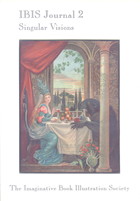Back To Publications List.
IBIS Journal 2: Singular Visions
 Journal 2 covers a broader canvas than the first, addressing the work of a more disparate selection of artists whose work spans a much longer period. It once again has 144 pages, finely printed on ivory paper. It has 27 full-colour illustrations and is presented in full colour laminated covers.
Journal 2 covers a broader canvas than the first, addressing the work of a more disparate selection of artists whose work spans a much longer period. It once again has 144 pages, finely printed on ivory paper. It has 27 full-colour illustrations and is presented in full colour laminated covers.
Robin de Beaumont provides an account of the life of Eleanor Vere Boyle, whose images of childhood are peopled by squat, earnest beings that seem always to have a vaguely sinister, threatening quality about them, even when portrayed playing in sunshine. Her landscapes have a dream-like quality that derives from a combination of Pre-Raphaelite hyper-reality with a strong sense of the gothic and the picturesque. When she sets out to introduce an element of horror to her work, as in the cover picture of Beauty and the Beast, then the effect is truly terrifying. Her beast, dragged out from some dark corner of her subconscious, is much farther removed from the human form than those of other artists.The article includes the first comprehensive bibliography of her work.
J.E. Millais was foremost among the Pre-Raphaelite brotherhood in leading a movement away from the Regency and early Victorian styles of illustration that sought to exaggerate and dramatise for comic or tragic effect, towards a more naturalistic style. He concentrates on the figures in his drawings, rather than on their environment. Where earlier illustrators showed the emotions and moods of their characters through facial expression or symbolic detail elsewhere in the picture, in Millais' work they are expressed by gesture and attitude. Paul Goldman argues that Millais was "The Consumate Illustrator".
Florence Upton's fame rests on her invention of the Golliwogg but, even without this character, her children's books, firmly grounded as they are in contemporary events and developments, would have been innovative and exciting to their young audience. There is a refreshing candour and freedom from moralising in the stories and a liveliness about the illustrations that had been lacking in the majority of earlier children's books. The frequent violent scrapes that her characters find themselves in must have given her readers a frisson of excitement whilst remaining confident that all would turn out all right in the end. Geraldine Beare's account of Upton's life and work is accompanied by a full listing of her book and magazine illustrations.
Vera Willoughby's early magazine illustrations are indistinguishable from the mass of 1890s work, but by the 1920s she was producing sophisticated and complex illustrations influenced by cubism, asian painting styles and the fashionable Art Deco sensibility. For a time she paralleled the work of Edmund Dulac and John Austen, but in her later work she developed a unique personal style akin to bas relief. This seems to be based on a synthesis of Assyrian carvings and mediaeval illumination, perhaps also informed by the work of Gill and Jones at Ditchling. Bill Connelly introduces readers to the life and work of this neglected illustrator.
These monographs are grouped around a study by Geoffrey Beare and Lorraine Janzen Kooistra of the illustrated editions of Coleridge's Rime of the Ancient Mariner which range in date from 1837 to 2000. The intensely visual quality of the poem has inspired at least 70 artists to attempt to illustrate it. But it is also that quality that, together with the emotional intensity of the verse, presents artists with such a challenge. Those capable of rising to it range from painters, such as David Scott and Patrick Procktor, tempted to make an occasional foray into the world of illustration, to established illustrators like Gustav Doré, Mervyn Peake and David Jones. Each produces an intensely original interpretation of the text, which whether representational and figurative in approach or near-abstract, represents a singular vision.
Copies of Journal 2 may be purchased by members and non-members. Click on "How to Buy" in the menu on the left for more details.
 Journal 2 covers a broader canvas than the first, addressing the work of a more disparate selection of artists whose work spans a much longer period. It once again has 144 pages, finely printed on ivory paper. It has 27 full-colour illustrations and is presented in full colour laminated covers.
Journal 2 covers a broader canvas than the first, addressing the work of a more disparate selection of artists whose work spans a much longer period. It once again has 144 pages, finely printed on ivory paper. It has 27 full-colour illustrations and is presented in full colour laminated covers.